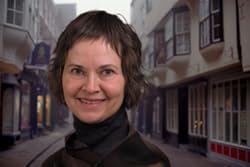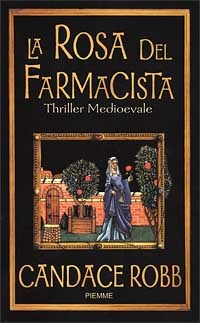Reviewed by Kevin J. Harty (harty@lasalle.edu)
To extend an allusion to Piers Plowman more than a bit,
small-screen medievalism has long been a fair field ripe for cultivation but
one hardly full of folk to do the cultivating.
The only full-length study of this form of medievalism that comes to
mind is Bert Olton’s excellent Arthurian
Legends on Film and Television, but, as comprehensive and invaluable as
Olton’s catalogue raisonné may be, it was published fifteen years ago. Other
than the occasional essay devoted to some individual television show or series,
the fertile field of small-screen medievalism sadly lies largely ignored and uncultivated,
despite the rich harvest it promises.
Such
lack of critical and scholarly attention is all that more curious given the
long history of small-screen medievalism. Pride of place as probably the earliest
example of small-screen medievalism belongs to the BBC six-episode Robin Hood broadcast live in March and April 1953, but, alas, no longer
available for viewing except in some very brief excerpts incorporated into
other television programs. British
television would, however, continue to embrace medievalism throughout the
so-called Golden Age of Television in the United Kingdom and in the United
States, the late 1950s and the early 1960s, when Britain’s independent channel,
ITV, produced in rapid succession, and then broadcast on both sides of the
Atlantic, The Adventures of Robin Hood,
Ivanhoe, The Adventures of Sir Lancelot, and The Adventures of William Tell—in many cases from scripts penned,
we now know, by blacklisted Hollywood screenwriters.
Small-screen
medievalism has come in waves. Each
decade since the 1960s has brought more series, or more individual episodes of
non-medieval series. Small-screen
medievalism has tended more often than not to be Arthurian or Hoodian, repeatedly
taking us to some version of Camelot or of the Greenwood, but, no matter where
it is set, small-screen medievalism comes in a variety of genres: broad comedy
(When Things Were Rotten and Maid Marian and Her Merry Men), equally
broad social commentary (Robin of
Sherwood and The Mists of Avalon),
sci-fi (episodes of Dr. Who and of Star Trek), pseudo-history (several
iterations of Ivanhoe and series such
as Covington Cross, Roar, and The Pillars of the Earth), cartoons (Prince Valiant, Clone High, and King Arthur’s Disasters), westerns
(episodes of Gunsmoke and of Bonanza), crime and mystery dramas (episodes
of Criminal Minds—one a two-part especially
gruesome bridge between seasons—of The
Avengers, and of Perception, as
well as the several season mini-series Cadfael),
fantasy and horror series (episodes of Charmed
and of Buffy the Vampire Slayer, and
a continuing major plot line in True
Blood involving vampires who were originally Viking warriors), and, in the
case of the latest example of small-screen medievalism, ABC television’s mini-series
Galavant, musical romantic comedy,
albeit very silly musical romantic comedy.
Musical comedy has embraced medievalism before on the stage (Spamalot, Pippin, Good Time Charley, and Twang!), but Galavant may be a first for small-screen medievalism. Billed by ABC as a four-week comedy extravaganza, Galavant is actually eight half-hour episodes that were presented in four double installments as fillers while the popular series Once Upon a Time, a show that itself dabbles at times in medievalism, was on hiatus. Galavant’s ratings were respectable enough, and the mini-series certainly ended with enough cliffhangers, but there has been no word yet as to whether the show will return for a second season any time in the future.
The
handsome eponymous hero (Joshua Sasse) is more slacker than he is Fair Unknown
as he sets out to mend his broken heart.
Unlike his counterparts in Spamalot,
he is not trying to find his Grail or his male, but his gal! She is the lovely Madalena (Mallory [such a wonderfully-appropriate
medieval first name!] Jansen) who is kidnapped as the series opens by the
not-quite-too-dastardly King Richard (Timothy Omundson). Richard at one point bills himself as a
“modern thirteenth-century man” when it comes to treating woman (and to hiding
the fact that he is still a virgin).
Madalena is hardly a typical damsel in distress though, since she
quickly decides life as Richard’s queen may have its advantages—not the least
of which is an extremely nimble and uninhibited court jester (Ben Presley) who
can more than satisfy the unmet sexual needs she continues to have thanks to Richard’s
closely-guarded virginity.
Galavant’s
immediate response to what turns out to be Madalena’s more-than-willing abduction
is to take to the bottle, but soon enough he is off on a quest—as any good
knight should be—to aid Princess Isabella of Valencia (Karen David), whose
kingdom Richard has conquered and is in the processing of starving to
death. On his quest, Galavant is joined
by his wise-cracking black squire, Sid (Luke Youngblood), who, we learn later
in the series, has suggested to his proud—Jewish, of course—parents that he is
the knight and Galavant is the squire.
The (mis)adventures on Galavant’s quest to free Valencia from Richard’s
tyranny are mainly an excuse to introduce a number of guest stars: Downton Abbey’s Hugh Bonneville and Sophie
McShera, John Stamos, Weird Al Jankovic, Ricky Gervais, Anthony Head, and
Rutger Hauer—and to showcase a number of musical numbers in a variety of
musical styles, with repeated nods to several Broadway musicals. In what may be the most inspired of these nods,
Richard’s cook (Darren Evans) sings a duet with his scullery maid girlfriend
(McShera) in which they plot to poison everyone at Richard’s court. That duet practically
genuflects in the direction of the duet about Mrs. Lovett’s pies from Sweeney Todd.
Galavant clearly wears its medievalism
on its sleeve—its claim to being an example of small-screen medievalism rests
on the fact that its episodes repeatedly incorporate tropes, narremes, and
motifs that a 21st century audience will easily identify as
medieval. Galavant is, of course, the
knight errant on performing deeds of derring-do with his squire in tow—they are
not quite Don Quixote and Sancho Panza, but they seem clearly in that
tradition. Galavant jousts with the
French knight Jean Hamm (Stamos), in a nod to Mad Men. There are two, not just one, damsels in distress (Madalena
and Isabella)—though no dragons or ogres. Richard does have a thuggish
right-hand man and all-around henchman, Gareth (Vinnie Jones). There is a cruel king—actually two—since Richard
only came to the throne when his older brother Kingsley (Hauer) renounced it,
though Kingsley returns later in the series to attempt to reclaim what is
rightfully his. Valencia also boasts a mostly hapless King and Queen (Stanley
Townsend and Genevieve Anthony). There are several turreted and moated castles. There is a Merlin-like wizard, Xanax
(Gervase), and a monastery, which is home to monks who are suitably tonsured
and robed, as we might well expect. The
monks of Valencia Monastery do not, however, take a vow to remain silent. Instead, they take a vow to sing in an
unceasing do wop rather than chant. There are peasants, but none the equal of
the Python’s politically-minded Dennis.
There is a dungeon and instruments of torture—think Inquisition light. There
are faux Saracens who attend the boy
Prince Harry to whom Isabella is, in a further plot complication, betrothed. Further complicating this plot complication
is the fact that Harry is also Isabella’s cousin who imprisons her in a toy
princess castle soon after Galavant has freed her from Richard’s. And, oh, there are pirates, whose ship has
run aground, rather inconveniently atop a mountain, and a Pirate King, Peter
the Pillager (Bonneville), though he is more a cross between Jack Sparrow and
Long John Silver in demeanor and costume than anything medieval. And guest stars Hauer and Head have each
appeared in separate small-screen retellings of the story of Merlin, Hauer as
Vortigern in the 1990s mini-series and Head as Uther in the more recent multi-season
cable channel series.
While Galavant attests to the continuing
fascination that the small screen has with medievalism, it is hardly the best
example of comic small-screen medievalism. That distinction belongs either to The Zany Adventures of Robin Hood or to When Things Were Rotten (or to both) in
the United States and to Maid Marian and
Her Merry Men in the United Kingdom.
The partly comic Kaamelott,
which ran on France’s M6 channel from 2005-2009, is in a class all by itself. Galavant
is harmless enough, silly, at times genuinely amusing—and American
television has in the past certainly renewed worse shows, so we could do with a
second season of the mini-series if only to resolve all those cliffhangers.
Kevin J. Harty, La Salle University





